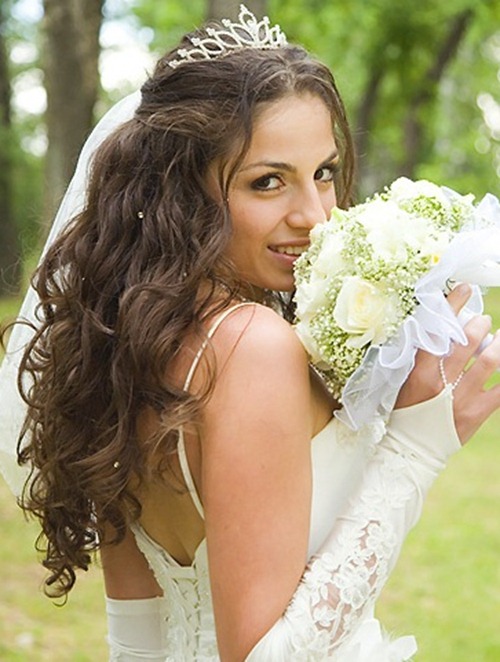Wedding Hairstyles Definition
Source link (google.com.pk)
Throughout history, people have worn their hair in a wide variety of styles, largely determined by the fashions of the culture they live in. Hairstyles are markers and signifiers of social class, age, marital status, racial identification, political beliefs and attitudes about gender.
In many cultures, often for religious reasons, women's hair is covered while in public, and in some, such as Haredi Judaism or European Orthodox communities, women's hair is shaved or cut very short, and covered with wigs. Only since the end of World War I have women begun to wear their hair short and in fairly natural styles
Ancient history
In ancient civilizations, women's hair was often elaborately and carefully dressed in special ways. Women coloured their hair, curled it, and pinned it up in a variety of ways. They set their hair in waves and curls using wet clay, which they dried in the sun and then combed out, or else by using a jelly made of quince seeds soaked in water, or curling tongs and curling irons of various kinds
Roman Empire and Middle Ages
Between 27 BC and 102 AD, in Imperial Rome, women wore their hair in complicated styles: a mass of curls on top, or in rows of waves, drawn back into ringlets or braids. Eventually noblewomen's hairstyles grew so complex that they required daily attention from several slaves and a stylist in order to be maintained. The hair was often lightened using wood ash, unslaked lime and sodium bicarbonate, or darkened with copper filings, oak-apples or leeches marinated in wine and vinegar.] It was augmented by wigs, hairpieces and pads, and held in place by nets, pins, combs and pomade. Under the Byzantine Empire, noblewomen covered most of their hair with silk caps and pearl nets.
From the time of the Roman Empire until the Middle Ages, most women grew their hair as long as it would naturally grow. Initially they wore it loose, held in place with a band around the brow and covered with a snood, kerchief or veil. From the ninth century until the 16th century, women began to wear their hair in extremely ornate styles, often decorated with pearls, precious stones, ribbons and veils. Women used a technique called "lacing" or "taping," in which cords or ribbons were used to bind the hair around their heads.[9] During this period, most of the hair was braided and hidden under wimples, veils or couvrechefs, and in the later half of the 15th century and on into the 16th century, wealthy women frequently plucked out hair at their temples and the napes of their necks, or used depilatory cream to remove it, if it would otherwise be visible at the edges of their hair coverings. Working-class women in this period wore their hair in simple styles.
Early modern history
Marie-Antoinette with pouf hairstyle
During the 15th and 16th centuries, European men wore their hair cropped no longer than shoulder-length, with very fashionable men wearing bangs or fringes. In Italy it was common for men to dye their hair.
From the 16th to the 19th century, European women's hair became more visible while their hair coverings grew smaller, with both becoming more elaborate, and with hairstyles beginning to include ornamentation such as flowers, ostrich plumes, ropes of pearls, jewels, ribbons and small crafted objects such as replicas of ships and windmills. Bound hair was felt to be symbolic of propriety: loosening one's hair was considered immodest and sexual, and sometimes was felt to have supernatural connotations.[Red hair was popular, particularly in England during the reign of the red-haired Elizabeth I, and women and aristocratic men used borax, saltpeter, saffron and sulfur powder to dye their hair red, making themselves nauseated and giving themselves headaches and nosebleeds. During this period in Spain and Latin cultures, women wore lace mantillas, often worn over a high comb, and in Buenos Aires, there developed a fashion for extremely large tortoise-shell hair combs called peinetón, which could measure up to three feet in height and width, and which are said by historians to have reflected the growing influence of France, rather than Spain, upon Argentinians.
In the middle of the 18th century the pouf style developed, with women creating volume in the hair at the front of the head, usually with a pad underneath to lift it higher, and ornamented the back with seashells, pearls or gemstones. In 1750, women began dressing their hair with perfumed pomade and powdering it white. Just before World War I, some women began wearing silk turbans over their hair
Wedding Hairstyles Form Long Hair Names Medium Length For Round Faces Short Layers Updos Over 50 2013
Wedding Hairstyles Form Long Hair Names Medium Length For Round Faces Short Layers Updos Over 50 2013
Wedding Hairstyles Form Long Hair Names Medium Length For Round Faces Short Layers Updos Over 50 2013
Wedding Hairstyles Form Long Hair Names Medium Length For Round Faces Short Layers Updos Over 50 2013
Wedding Hairstyles Form Long Hair Names Medium Length For Round Faces Short Layers Updos Over 50 2013
Wedding Hairstyles Form Long Hair Names Medium Length For Round Faces Short Layers Updos Over 50 2013
Wedding Hairstyles Form Long Hair Names Medium Length For Round Faces Short Layers Updos Over 50 2013
Wedding Hairstyles Form Long Hair Names Medium Length For Round Faces Short Layers Updos Over 50 2013
Wedding Hairstyles Form Long Hair Names Medium Length For Round Faces Short Layers Updos Over 50 2013
Wedding Hairstyles Form Long Hair Names Medium Length For Round Faces Short Layers Updos Over 50 2013
Wedding Hairstyles Form Long Hair Names Medium Length For Round Faces Short Layers Updos Over 50 2013


.jpg)







No comments:
Post a Comment